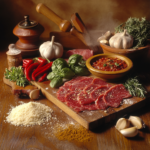Italian Braciole with Red Peppers
Braciole, also known as involtini, is a beloved Italian comfort dish made with thinly sliced beef rolled around a flavorful filling. While many traditional recipes include raisins, this version swaps them out for diced red bell peppers—adding a pop of sweetness and color without the fruit. Simmered in a rich marinara sauce, these beef rolls become meltingly tender and packed with old-world flavor. Perfect for Sunday dinner or a special gathering.
- Yield: 4 1x
- Category: Beef
- Method: Oven
- Cuisine: Italian
Ingredients
For the Braciola Rolls:
1 1/2 lbs thinly sliced beef top round (or flank steak)
1/2 cup Italian-style breadcrumbs
1/4 cup grated Parmesan or Pecorino Romano cheese
2 tablespoons chopped fresh parsley
2 tablespoons pine nuts (optional but classic)
2 garlic cloves, minced
1/3 cup diced roasted red peppers (jarred or homemade) 0r 1/4 cup golden raisin (tradional)
Salt and black pepper to taste
Kitchen twine or toothpicks
For the Sauce:
2 tablespoons olive oil
1 small onion, finely chopped
2 garlic cloves, minced
1 (28 oz) can crushed tomatoes
1 (15 oz) can tomato sauce
1/2 teaspoon red pepper flakes (optional)
Salt and pepper to taste
Fresh basil or parsley for garnish
Instructions
-
Prep the Filling:
In a small bowl, combine breadcrumbs, cheese, parsley, pine nuts, garlic, and diced roasted red peppers. Season with a pinch of salt and pepper. -
Assemble the Braciola:
Lay out beef slices. Pound thinner if needed. Add 1–2 tablespoons of the filling on each slice. Roll tightly and secure with twine or toothpicks. -
Brown the Rolls:
In a large Dutch oven or deep skillet, heat olive oil over medium heat. Sear the braciola on all sides until nicely browned. Remove and set aside. -
Make the Sauce:
In the same pan, sauté onions and garlic until soft. Stir in crushed tomatoes, tomato sauce, red pepper flakes (if using), salt, and pepper. Bring to a simmer. -
Simmer to Tender:
Return the braciola to the pan. Cover and simmer gently on low heat for 1 ½ to 2 hours until the meat is fork-tender. -
Serve:
Remove the braciola, cut and serve with sauce over pasta or polenta. Garnish with fresh herbs and extra cheese if desired.
Notes
🍷 Serving Suggestions:
Pair with creamy polenta, tagliatelle, or a hearty red wine like Chianti or Barolo.
For braciole, the beef should be pounded to about 1/4 inch thick (6 mm).
This thickness makes it:
-
Easy to roll without tearing
-
Able to hold in the stuffing
-
Tender after a long simmer in sauce
You can ask your butcher to slice top round or flank steak thin, or buy it and pound it yourself with a meat mallet between two pieces of plastic wrap or parchment
Here’s a quick breakdown:
🟢 Optional but Traditional:
-
Golden raisins (or currants) are often used to add a subtle sweetness that balances the richness of the meat and cheese.
-
In older family recipes, especially those passed down from Sicilian grandmothers, raisins are a nostalgic, signature touch.
🔴 Can Be Skipped or Substituted:
-
If you’re not a fan of raisins, you can absolutely leave them out.
-
Or try substitutions like:
-
Chopped sun-dried tomatoes (for a richer, slightly tangy note)
-
Caramelized onions (adds natural sweetness)
-
Diced roasted red peppers (brings a soft sweetness and color)
-
Traditionally, Southern Italian braciola recipes often include raisins or currants in the filling. This sweet-and-savory combination dates back generations, especially in Sicily and Naples. However, for those who prefer a more savory flavor profile, swapping raisins for diced roasted red peppers brings a mellow sweetness without the fruitiness. It’s a perfect update that honors tradition while adapting to modern tastes.
Braciola or Braciole?
Great question! The answer depends on how many you’re talking about:
-
Braciola (brah-CHO-lah) is the singular form — one stuffed beef roll.
-
Braciole (brah-CHO-lee) is the plural — more than one.
So if you’re serving this as a dish with multiple rolls (which is usually the case), you’d call it Braciole. But if you’re referring to just one, then it’s Braciola.
In casual American-Italian usage, people often just say “braciole” for the dish in general — kind of like “lasagna,” even though “lasagne” is the proper plural in Italian.
If you’ve ever eaten in a true Italian-American kitchen, you know these rolls are made with love — and that the real secret ingredient is always the story behind them.
Nutrition Disclaimer: The nutritional information provided is an estimate based on standard ingredients and serving sizes. Actual values may vary depending on specific products used and portion sizes. This information is provided for convenience and should not be considered medical or dietary advice.
Nutrition
- Serving Size: approx, 6 oz with sauce
- Calories: 410
- Fat: 22
- Carbohydrates: 14
- Protein: 38
